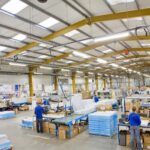Imagine a factory at midnight with dark corridors and silent machines. Suddenly, there’s a piercing noise. A scream? No, it’s the metal clamping shut, preparing for the injection process.
Prototype injection molding can seem like a monster. Unknown, terrifying, but don’t turn away. It’s not magic, but science.
Prepare as we venture into this labyrinth and uncover the secrets of this process. You’ll learn how it works, why it’s essential, and how you can get started.
Let’s begin!
Understanding the Materials
Different kinds of materials are used in this process. It typically includes:
- thermoplastics
- elastomers
- thermosets
Thermoplastics can be melted and re-molded repeatedly without significant degradation. On the other hand, elastomers, like rubber, provide excellent flexibility, ideal for elastic components.
As for thermosets, they are polymers that cannot be melted and reprocessed. This material is best for creating durable parts, but it’s not suitable for prototyping.
The Molding Process
The molding process begins with the preparation of the material. Typically, the chosen plastic is in pellet form. These pellets are fed into a heated barrel.
The pellets are heated and transformed into a liquid state, ready for the injection process. Once the material is in its molten form, it’s injected at high pressure into a mold cavity.
The mold, usually steel or aluminum, has cavities to shape the product. After the material has been injected into the mold, it undergoes cooling to solidify.
Once cooled, the mold opens, and the newly formed part is ejected.
Design Considerations
When designing, keep it simple as complex designs can lead to problems. Ensure complete mold fill and avoid undercuts. These features make ejection difficult.
Additionally, wall thickness matters as it prevents warping. Too thick, and it can cause sink marks. Too thin, and it may not fill properly.
Also, consider draft angles to make ejection easier. Without them, the part can be stuck in the mold.
Machinery and Equipment
To produce quality prototypes, you’ll need specialized machinery and equipment. For instance, high-precision injection molding machines ensure consistent and accurate parts.
For ABS Plastic Injection Molding, precise control of temperature and pressure is crucial for optimal results. You’ll also need molds, designed specifically for your part. They can be expensive, but some companies offer cost-effective solutions like 3D printing.
Finally, you’ll need post-processing equipment for finishing touches like trimming excess flash.
Quality Control and Testing
Quality control ensures the product meets specifications and is defect-free. One way to ensure this is through testing using a variety of methods such as:
- visual inspection
- measurement
- mechanical testing
These tests can help identify any issues with the prototype before moving on to mass production. Plus, they aid in improving the design for better functionality and durability.
Benefits of Prototype Injection Molding
Prototype injection molding is a popular method for creating prototypes due to its many benefits. It is:
- cost-effective
- offers quick turnaround times
- produces accurate results
- realistically depicts the final product
With proper understanding and preparation, it can be an effective tool for high-quality prototypes.
The Future of Rapid Prototyping
Prototype injection molding is an indispensable process in product development. It allows you to test, refine, and perfect your designs quickly. The learning curve may seem steep, but the rewards are immense.
Don’t let hesitation hold you back. Explore how it can transform your concepts into reality. The world is waiting for your next big idea!
Did you find this article helpful? Check out the rest of our blog now!















